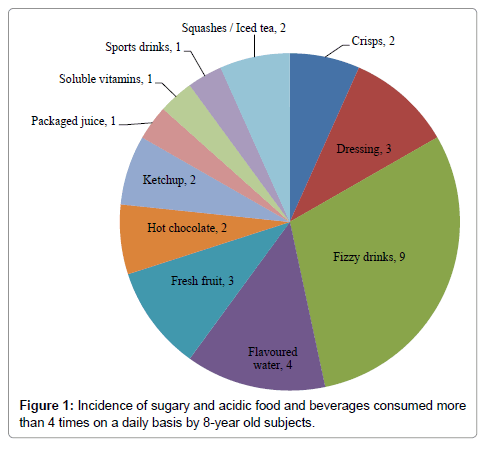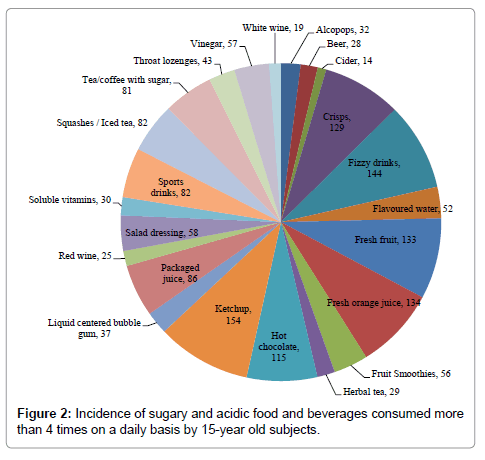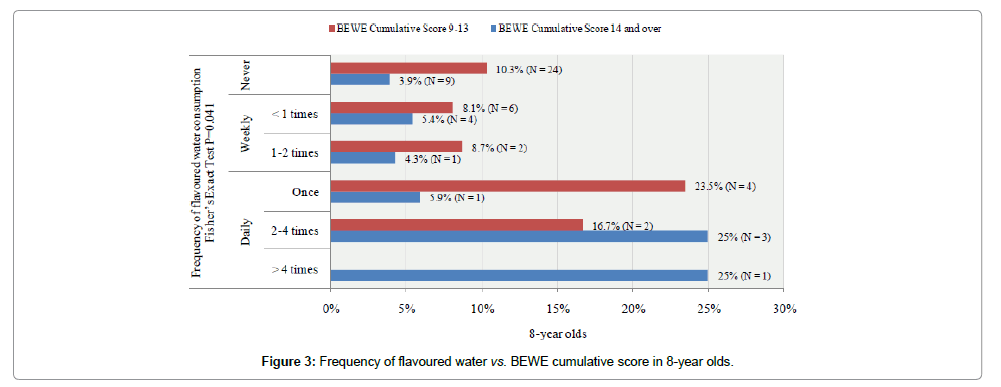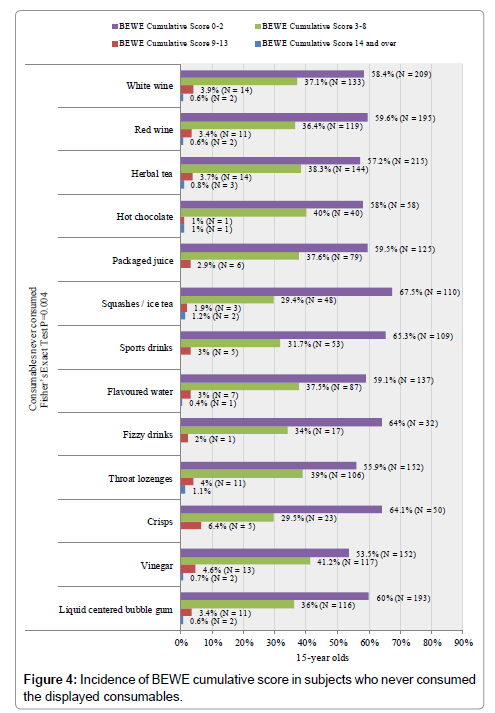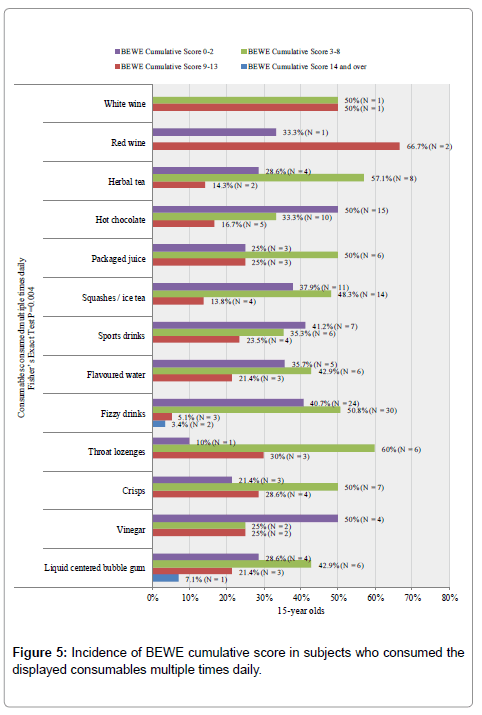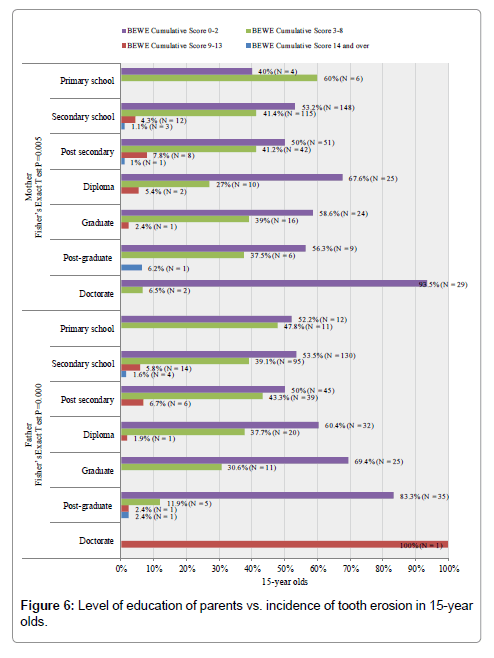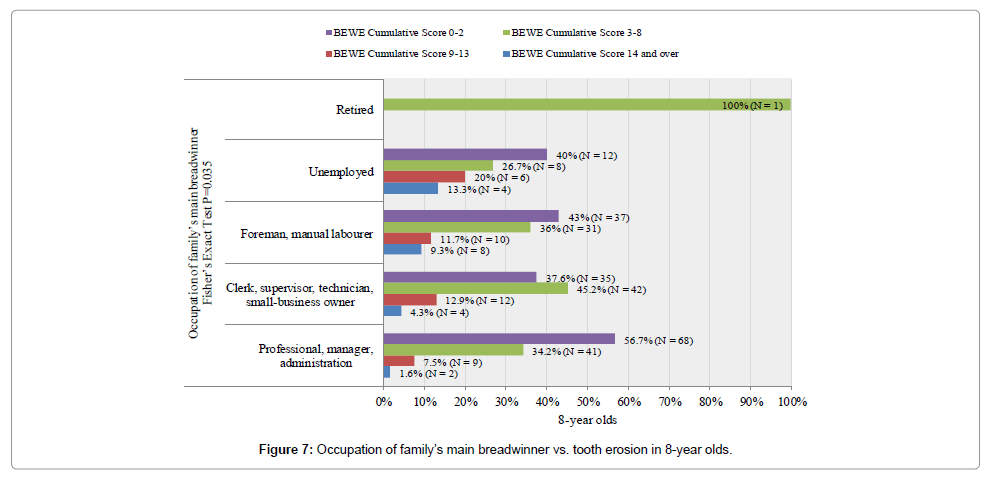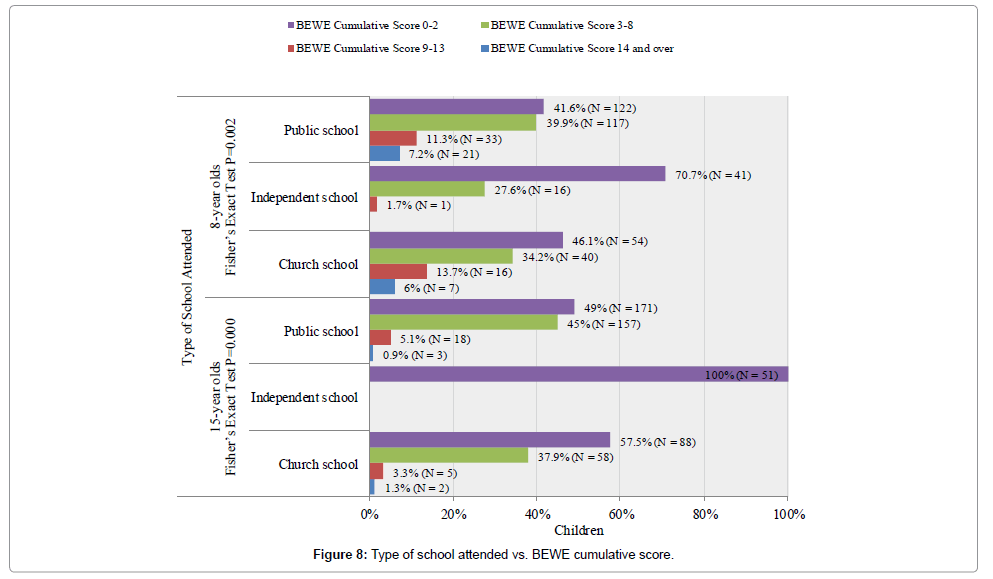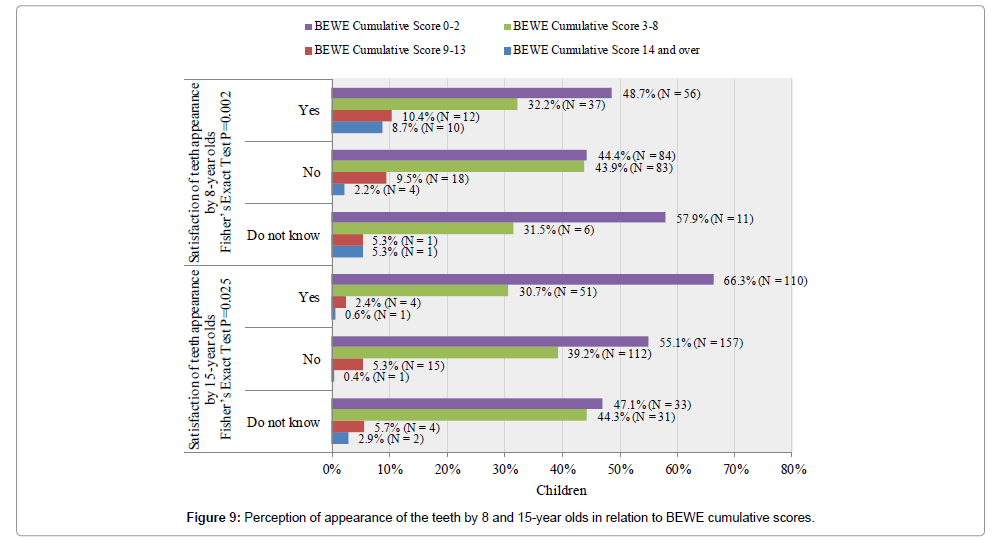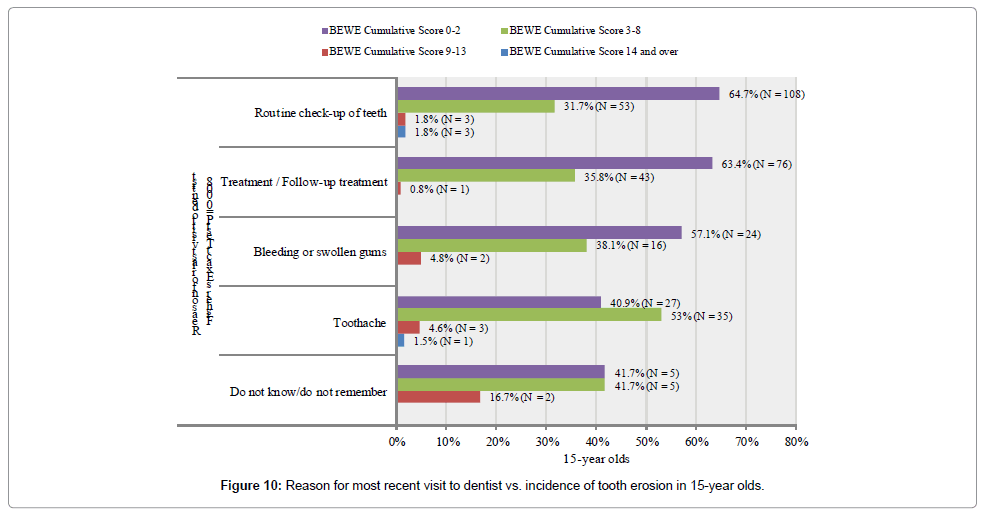Research Article Open Access
The Socioeconomic Impact on Tooth Wear in Children
Miriam Schembri* and Nikolai AttardDepartment of Oral Rehabilitation and Community Care, Faculty of Dental Surgery, University of Malta Medical School, Mater Dei Hospital, Block A, Level O, B’Kara Bypass, Msida MSD2090, Malta
- *Corresponding Author:
- Schembri M
Research Associate
Department of Oral Rehabilitation and Community Care
Faculty of Dental Surgery, University of Malta Medical School
Mater Dei Hospital, Block A, Level O
B’Kara Bypass, Msida MSD2090, Malta
Tel: (00356) 23401875
E-mail: miriamschem@gmail.com
Received Date: February 07, 2017; Accepted Date: March 18, 2017; Published Date: March 25, 2017
Citation: Schembri M, Attard N (2017) The Socioeconomic Impacts on Tooth Wear in Children. Pediatr Dent Care 2: 136.
Copyright: © 2017 Schembri M, et al. This is an open-access article distributed under the terms of the Creative Commons Attribution License, which permits unrestricted use, distribution, and reproduction in any medium, provided the original author and source are credited.
Visit for more related articles at Neonatal and Pediatric Medicine
Abstract
Aim: The aim of this paper is to discuss the impact of dietary, educational and behavioural variables on tooth erosion patterns in a cross-sectional study in a sample of 8- and 15-year olds. Methods: Ten percent (10%) of the current 8- and 15-year olds of the Maltese population were randomly selected. The sample was representative of geographical regions, gender and type of school attended (state, church and independent schools). Four hundred thirty nine (439) of 8-year and 555 of 15-year olds were examined in a standardized fashion. The subjects were asked to fill in a questionnaire to give an indication of their social, oral hygiene, dietary and medical history. The Basic Erosive Wear Examination Index (BEWE) was used to measure the erosion scores. Results: In both age groups a number of food and beverage items were significantly related to the levels of tooth erosion in both age groups. Likewise, socioeconomic aspects, such as the education levels of both parents, type of schooling and parental occupational status for the 8-year olds, were significantly associated with the level of tooth erosion. Oral hygiene habits were also significantly associated to tooth erosion in the 15-year olds. Multivariate linear regression models were carried out for both age groups- in the 8-year olds, the three significant variables were BMI, the family’s main breadwinner’s employment and brushing technique. In the 15-year old subjects, the likelihood of tooth wear incidence increased in the subjects when attending a public school, whose parents attained a low level of education, whose last visit to the dentist was triggered by pain, did not brush the teeth frequently and mostly consumed sugary beverages. Conclusions: This study indicates that dental erosion was associated with various behavioural and socioeconomic contributing factors which were observed to have a correlation to the incidence of the subjects’ tooth erosion.
Keywords
Children; Dental erosion; Tooth erosion; Socioeconomic; Sugary beverages; Oral hygiene
Introduction
Literature has observed that tooth wear erosive lesions were time and behaviour dependent. Tooth surface loss has been largely linked to the high consumption of soft drinks, fruit juices and carbonated drinks [1], with the contribution of dental erosion to tooth wear particularly among children and young adults increasing in prevalence [2]. Careful observation and clinical experience led us to hypothesize a progression of these lesions with time despite dietary counselling and oral hygiene instructions [3].
The role of diet in the aetiology of dental erosion has received the most attention. Dietary acids are undoubtedly the principle causative factor for extrinsic tooth erosion [4]. The consumption of fruits and fruit juices is one of the risk factors most significantly related to this dental hard tissue defect [5]. Early observations in the dental literature on the role of acidic foods in dental erosion date back to Miller [6]. In a study carried out by Milward et al., on Swiss adults it was found that bedtime consumption of fruit juices was strongly associated with the most severe cases of erosion [7]. High rates of erosion were also associated to the consumption of acidic beverages at bedtime by studies carried out by Lewis and Smith [8]. Other abusive or unusual consumption of acidic beverages have been reported to cause severe tooth loss. One report described an unusual pattern of dental erosion in a person who had a past habit of holding a cola beverage in his mouth until all the carbonation has dissipated [9]. Another parafunctional habit connected to dental erosion includes swishing concentrated orange or carbonated drink between the teeth before swallowing [10]. Several authors have recommended the drinking of acidic beverages through a straw introduced into the mouth past the teeth [11]. However, there are case reports that indicate that unusual methods of drinking a fruit-flavoured cordial or a fruit drink with a straw caused marked erosion of the anterior teeth [10]. More recently there have been several reports that have raised a concern about an increased prevalence of dental erosion and tooth wear in children. These are mainly related to the recent dramatic increase in the consumption of acidic fruit juices, fruit drinks and carbonated beverages [12]. Also the popular drinks alcopops especially among young females were found to have a highly erosive effect on dental hard tissues due to the fact that they are based on fruits with high citric acid content and also the alcohol content increases the risk of vomiting [13,14].
Järvinen et al. suggest that internal factors, such as disorders with vomiting, regurgitation or reflux of gastric contents, have been crucial in approximately one quarter of all cases of dental erosion [15]. Vomiting is commonly a manifestation of many organic and psychosomatic disorders for example anorexia and bulimia nervosa [16]. Anorexia has been reported in children as young as 11 years of age [17]. A study has also reported an increased prevalence of erosion in asthmatic children. This was attributed both to anti asthmatic medications and association of Gastroeosophageal Reflux Disease with asthma [18]. Moreover it is worth noting that children with cerebral palsy have a high incidence of Gastroeosophageal reflux. This together with the increased tendency towards bruxism puts these children at a greater risk for erosion [19].
Dental erosion associated with Gastro-oesophageal reflux disease has also been reported in 3- and 8-year old children [20]. The refluxed acid typically dissolves the palatal surfaces of the upper incisors [21]. This will be followed later by the palatal and occlusal surfaces of the upper premolars and molars. The lower teeth remain largely undamaged [22]. On the other hand in a study carried out on an 8-year old girl suffering from asymptomatic gastroeosophageal reflux especially at night, dental erosion in deciduous dentition was found in both the maxillary and mandibular anterior teeth as well as the upper and lower molars in contrast to adult patients [23,20]. Several other studies have evaluated the relationship between the socioeconomic status and dental erosion. Certain lifestyle and behavioural factors should be considered in the aetiology of dental erosion [24]. Unusual eating, drinking and swallowing habits which increase the direct contact time of acidic foods and beverages with the teeth increase the risk of dental erosion. There is strong evidence to suggest that the manner in which the acid food or drink is consumed is more important than the overall quantity. Holding, swirling or retaining acidic drinks and foods in the mouth prolongs the acid exposure on the teeth increasing the risk of erosion [25]. Studies have also presented conflicting results with regards to the relationship between the dental erosion and socioeconomic status. Millward et al. reported that 4-year old children from a low socioeconomic group had statistically significantly less erosion than children from higher socioeconomic groups. The observed differences between the groups may be due to differences in dietary patterns and oral hygiene practices [7]. In contrast Milosevic et al. reported that the prevalence of tooth wear in 14-year old children was slightly positively associated with the level of social deprivation in the areas where the children were living [26]. Individuals involved in strenuous sporting activities may be at higher risk of dental erosion because of more frequent ingestion of acidic sports drinks, fruit juices and other carbonated or uncarbonated beverages [27]. Also exercise increases the loss of body fluids and may lead to dehydration and decreased salivary flow.
People are increasingly concerned on healthier diets which include the consumption of acidic foods such as salad dressing and citrus fruits [28]. Tooth brushing immediately after an acid challenge removes the partially demineralised tooth structure before saliva can repair it. In this case, erosion and abrasion work synergistically to promote development of non-carious cervical lesions [29]. Brushing with a dentifrice will remove the acquired pellicle and render the enamel surface more susceptible to acid erosion. [30]. Lussi and Schaffner found a direct correlation between frequency of tooth brushing and tooth wear lesions particularly cervical lesions [3]. The addition of fluoride to acid solutions and beverages has been shown to decrease the amount of erosion in animal models [31]. Also topical application with high concentration fluoride varnish or solution was effective in inhibiting enamel softening by a carbonated cola beverage in vitro [32].
It is the aim of this study to discuss the impact of socioeconomic variables on tooth erosion patterns in a cross-sectional study of a sample of 8- and 15-year old children.
Materials and Methods
The study was carried in 2015. Ethical approval was obtained from the University of Malta. The consent to examine the selected children was obtained from the respective legal guardians and respective school authorities. The authors underwent the necessary training and calibration prior to embarking the clinical survey.
Patient groups and selection
Ten percent of the two age groups, 8 and 15-year olds, were randomly selected to participate in the study. Randomisation was carried out with the help of a statistician and was based on gender, geographical region and school attended (State, Church and Independent Schools). The subjects, or in the case of the 8-year olds the parents, were also asked to fill in a questionnaire on their demographic, behavioural, medical and dental history.
Tooth wear index
The Basic Erosive Wear Examination Index (BEWE) [33] was used to measure the erosion scores and the calculated cumulative score values were later divided into four risk categories in accordance with the risk level guide to clinical management as outlined by Bartlett et al., [33].
During the study, the buccal/labial, palatal/lingual and occlusal/ incisal of the subjects’ teeth were examined and the most severely affected surface in each sextant was recorded into the four level BEWE score grades.
Data collection
The study involved data collection by means of questionnaires and the clinical oral examination of the subjects.
The questionnaires prepared for the respective age groups were designed to obtain information regarding the social status of the subjects, oral hygiene practices and subjects’ medical history. A substantial part of the questionnaires included detailed questions relating to study subjects’ dietary habits including consumption of fizzy drinks, fruit juices, flavoured water and other acidic food and beverages. Participants were asked to rate their intake frequency between ‘multiple times daily’, ‘once daily’, ‘multiple times weekly’, ‘once weekly’, ’multiple times monthly’ or ‘never’ for a presented list of acidic food and beverages.
The next phase of the study was the clinical examination in the subjects’ respective schools. The examination by a team of standardised dentists involved the use of a portable dental chair, a mobile dental unit and a standardised Daray lamp (Daray X200LED examination light).
Height was measured using a portable stadiometer - SECA 214 Portable Stadiometer, whilst weight was recorded using a portable SECA digital scales, both instruments consistently used throughout the study.
The height and weight were measured to calculate the Body Mass Index (BMI) for each study subject and the resulting BMI values measured in kg/m2 were classified into 4 categories as identified by the World Health Organisation (WHO), namely, an underweight group, 2 average weight groups and an overweight group [34]. This was discussed in a previous study.
Statistical analysis
Data analysis was carried out using SPSS 20 system for Windows (SPSS 20, SPSS Inc. Chicago, IL, USA) as follows:
Univariate analysis: Descriptive statistics were carried out to investigate the population that was studied.
Bivariate Analysis: Pearson chi-square test or Fisher’s exact test was used to analyse the association between two categorical variables such as type of school attended by study subjects and the BEWE score.
Unpaired t-tests were carried out to calculate the association between the mean BEWE cumulative scores of the two age groups and also between the mean BEWE cumulative scores and continuous variables.
Sextant BEWE scores 3 were correlated to dietary variables by Spearman’s rank correlation coefficient (rs <0.05).
Multivariate analysis: A multivariate linear regression model was carried out for both age groups to identify which the determining factors for the incidence of tooth erosion.
In all tests carried out, statistical significance was set at a p-value < 0.05.
Results
Dietary contributing elements
In general, it was noted that the consumption of sugary and acidic drinks and foods was quite low, and a high response in the ‘Never’ or ‘Less than once a week’ options was reported compared to the ‘Once a day’ and ‘Multiple times a day’ responses.
However, slightly higher consumption values of sugary and acidic sources were reported within the 15-year olds group compared to the 8-year olds group. This finding could be explained as the older children tend to follow their own dietary preferences and are more exposed to peer pressure compared to the younger subjects whose dietary practices are usually established by the parents.
We have observed that some subjects in each of the two age groups consumed a number of acidic or sugary food items or beverages more than 4 times daily. These consumables included fizzy drinks, flavoured water, hot chocolate, squashes or iced tea, packaged juices, sports drinks and ketchup. The findings are represented in Figures 1 and 2.
Flavoured water was the only drink significantly linked to erosion within the 8-year olds group. We noted that within the category of subjects who never consume flavoured water there was a decreased reporting of subjects as the severity of tooth erosion increases as outlined in Figure 3.
In the 8-year olds group, the observed BEWE scores of 3 in the upper anterior sextant were statistically related, by Spearman’s correlation coefficient, to the consumption of fizzy drinks, packaged juice and soluble vitamins as shown in Table 1.
| Sextant | ||||||
|---|---|---|---|---|---|---|
| Food | 16-54 | 53-63 | 64-26 | 36-74 | 73-83 | 84-46 |
| rsValue | rsValue | rsValue | rsValue | rsValue | rsValue | |
| Fizzy drinks | * | 0.023 | * | * | * | * |
| Packaged juice | * | 0.030 | * | 0.000 | 0.007 | 0.001 |
| Soluble vitamins | * | 0.032 | * | * | * | * |
*Spearman’s correlation coefficient rs>0.050
Table 1: rs Values for the correlation of acidic and sugary foods and beverages in relation to BEWE score 3 for 8-year olds’ sextants.
Within the 15-year olds group, BEWE cumulative scores were significantly related to the consumption of fizzy drinks, flavoured water, sports drinks, squashes, ice tea, packaged juice, hot chocolate, liquid centred bubble gum, vinegar, white wine, red wine, crisps, throat lozenges and herbal tea. There was a consistent trend observed where the percentage of subjects in the ‘14 and over’ category of tooth erosion increased as the consumption of the listed items increases. In some instances, in the 15-year olds group some consumables were consumed more than 4 times daily.
Figures 4 and 5 show the incidence of tooth erosion based on nonconsumption or multi-daily consumption of the above listed acidic and sugary food and beverages which were significant correlation to the incidence of tooth erosion in 15-year old patients.
Moreover the results in Tables 2 and 3 showed that in the 15- year olds group, the consumption of fizzy drinks, tea and coffee with sugar, packaged juice, squashes, iced tea, flavoured water and sports drinks had an erosive effect on most sextants. Sextant 13-23 was mostly affected by fizzy drinks, followed by squashes, iced tea and vinegar. It can be argued that these three contributing factors play a very important role in the incidence of tooth erosion considering that 65.2% of all the BEWE score highest scores (3) are reported to in the 13-23 sextant.
| Sextant | ||||||
|---|---|---|---|---|---|---|
| Food | 17-14 | 13-23 | 24-27 | 37-34 | 33-43 | 44-47 |
| rsValue | rsValue | rsValue | rsValue | rsValue | rsValue | |
| Liquid centred bubble gum | 0.007 | * | 0.033 | * | * | * |
| Fizzy drinks | 0.016 | 0.001 | 0.005 | 0.001 | * | 0.000 |
| Hot chocolate | * | * | 0.023 | 0.019 | * | 0.020 |
| Tea / Coffee with sugar | 0.030 | * | 0.012 | 0.029 | * | 0.044 |
| Fresh orange juice | * | * | * | * | 0.043 | * |
| Packaged juice | 0.001 | * | 0.038 | 0.003 | * | 0.025 |
| Squashes / iced tea | 0.000 | 0.001 | 0.005 | 0.002 | 0.049 | 0.000 |
| Flavoured water | 0.023 | * | 0.029 | 0.000 | * | 0.000 |
| Herbal tea | 0.042 | * | * | * | * | * |
| Sports drinks | 0.000 | * | 0.033 | 0.016 | * | 0.003 |
| Crisps | * | * | * | * | * | 0.028 |
| Throat lozenges | * | * | * | 0.009 | * | * |
| Soluble vitamins | * | * | * | * | 0.029 | * |
| Salad dressings | * | * | 0.024 | 0.017 | * | 0.012 |
| Vinegar | * | 0.004 | * | * | 0.007 | * |
*Spearman’s correlation coefficient rs>0.050
Table 2: rs Values for the correlation of acidic and sugary foods and beverages in relation to BEWE score 3 for 15-year olds’ sextants.
| Drink | Subjects with BEWE cumulative score | |||||||
|---|---|---|---|---|---|---|---|---|
| 0-2 | 3-8 | 9-13 | 14 and over | |||||
| N | % | N | % | N | % | N | % | |
| Water | 214 | 60.1% | 131 | 36.8% | 10 | 2.8% | 1 | 0.3% |
| Sugary drinks (flavoured water, ice tea, fruit juice) | 70 | 50.0% | 57 | 40.7% | 9 | 6.4% | 4 | 2.9% |
| White milk | 11 | 57.9% | 6 | 31.6% | 2 | 10.5% | - | - |
| Tea/coffee with sugar | 3 | 33.3% | 6 | 66.7% | - | - | - | - |
Fisher’s Exact Test P=0.011
Table 3: Correlation of most consumed drink and incidence of tooth erosion for 15-year olds.
These significant results were observed for the beverage mostly consumed by the subjects as well as the beverages consumed during sports activities as reported in Table 4.
| Drink | Subjects with BEWE cumulative score | |||||||
|---|---|---|---|---|---|---|---|---|
| 0-2 | 3-8 | 9-13 | 14 and over | |||||
| N | % | N | % | N | % | N | % | |
| Water | 243 | 56.9% | 167 | 39.1% | 16 | 3.8% | 1 | 0.2% |
| Energy drink | 24 | 72.6% | 5 | 15.2% | 2 | 6.1% | 2 | 6.1% |
| Other sugary drink | 8 | 47.0% | 6 | 35.3% | 2 | 11.8% | 1 | 5.9% |
| Water+sugary drink and/or energy drink | 11 | 42.3% | 11 | 42.3% | 3 | 11.5% | 1 | 3.9% |
Fisher’s Exact Test P=0.000
Table 4: Correlation of drink consumed during sports activities and incidence of erosion for 15-year olds.
In both instances, higher percentages of subjects that consume sugary drinks have been observed to classify in the BEWE cumulative scores’ “medium and high risk” groups.
Socio-Economic status; and type of school attended
The effect of the level of education of both parents on the incidence of tooth erosion present in their children has been analysed and the resulting relationship was statistically significant using Fischer’s Exact test at p=0.035 for the 15-year old subjects as represented in Figure 6.
There is a gradual increase in the percentage of subjects at no risk of tooth erosion as the highest level of the mothers’ education attained improves from primary school level education to a post-graduate level.
Similarly data collected concerning the main breadwinner of the household for the interviewed subjects revealed a statistically significant relationship between the level of tooth erosion and the occupation of the main breadwinner of the 8-year old subjects’ family as presented in Figure 7.
The type of school attended by the subjects was found to be statistically significant for both age groups in relation to the incidence might have some psychological effects on the affected subjects. The findings are reported in Figure 9.
In the 15-year olds group, significant correlations were observed of erosion observed, the latter being highest for students attending public schools and lowest reported in students attending independent schools (Fisher’s Exact test: p=0.000) as outlined in Figure 8.
Self-perception of oral health and dental appearance; Oral hygiene habits; Toothpaste preference; and Visits to the dentist
Subjects were asked to describe their own state of health of their teeth as per Table 5.
| Health of teeth | 8-year olds | 15-year olds | ||
|---|---|---|---|---|
| N | % | N | % | |
| Excellent | 20 | 6.3% | 19 | 3.6% |
| Very good | 80 | 25.2% | 103 | 19.6% |
| Good | 132 | 41.5% | 211 | 40.2% |
| Average | 69 | 21.7% | 153 | 29.1% |
| Poor | 10 | 3.1% | 12 | 2.3% |
| Very poor | 2 | 0.6% | 1 | 0.2% |
| Do not know | 5 | 1.6% | 26 | 5.0% |
| Total | 318 | 100% | 525 | 100% |
| No response | 151 | 38 | ||
Table 5: Self-perception of health of teeth in 8 and 15-year olds.
Of note, the highest percentage of respondents in both age groups perceive their oral health as ‘Good’ followed by respondents deeming their personal oral health as ‘Very good’ or ‘Average’.
Very few respondents classify their oral health as poor or very poor.
In both age groups, no significant correlation was found between the subjects’ perception of dental health and the incidence of tooth erosion, possibly indicating that patients suffering from tooth erosion might be unaware of, or do not appreciate the problem.
On the other hand, the relation between self-reported perceptions of teeth appearance to the incidence of tooth erosion was significant in both 8 and 15-year old groups. This is an indication that tooth erosion between the incidence of tooth erosion and i) the frequency of tooth brushing (p=0.000) and ii) the time when the teeth were brushed (p=0.001). Of note, a significant majority (63.8%) of 15-year old subjects who brush their teeth before eating breakfast were at the least risk of tooth erosion compared to 54.9% of the subjects who do not brush their teeth before breakfast.
Furthermore, the type of toothbrush used by the 15-year olds was statistically related to level of tooth erosion and the BEWE score reported.
The majority of 15-year old patients using a soft-bristled (57.4%) or medium-bristled (57.4%) toothbrush were at no risk of tooth erosion. However 15.4% of patients brushing their teeth with a hard-bristled scored a BEWE cumulative score of 9-13, being the highest percentage within the two most severe tooth erosion scores range.
The subjects’ use of toothpaste with different fluoride content and the incidence of tooth erosion were explored. Of note, 52.6% and 7.9% of the subjects that did not use adult toothpaste with fluoride were within the BEWE score 3-8 and 9-13 respectively which are relatively high percentage levels compared to subjects using the adult fluoridated toothpaste.
We also explored the reasons for the subjects’ most recent dental visit. In the 15-year olds subjects this variable was significantly related to the incidence of tooth erosion observed in the subjects as reported in Figure 10.
Interestingly, 53% of the 15-year olds that have visited the dentist suffering from toothache are within the 3-8 BEWE score group, being the highest percentage of prevalence of this level of tooth erosion compared to subjects visiting the dentist for other reasons.
Multivariate linear regression model
A multivariate linear regression model was carried out for both age groups to identify which the determining factors for the incidence of tooth erosion.
In the 8-year olds group, as presented in Table 6, the three variables that remained statistically significant were BMI, the main breadwinner’s employment and brushing technique. Thus tooth erosion in an 8-year old was more likely to be reported for subjects that have a high BMI, whose parents have an unskilled job and brush their teeth in a vertical or horizontal motion as opposed to circular motion.
| Variable | Unadjusted | Adjusted | ||
|---|---|---|---|---|
| Effect | p-Value | Effect | p-Value | |
| Type of School | + | 0.002 | / | >0.050 |
| BMI (categorized) | + | 0.003 | + | 0.041 |
| Parents’ job | - | 0.035 | - | 0.001 |
| Brushing motion | + | 0.070 | + | 0.026 |
| Adult toothpaste with fluoride | + | 0.006 | / | >0.050 |
| Drink most | + | 0.080 | / | >0.050 |
| Flavoured water | + | 0.040 | / | >0.050 |
| Heart burn | + | 0.060 | / | >0.050 |
Table 6: Multivariate linear regression model for 8-year olds.
In a 15-year old subject, the likelihood of tooth wear incidence increased in the subject who attends a public school, whose father attained a low level of education, whose last visit to the dentist was triggered by a toothache, did not brush the teeth frequently and mostly consumed sugary beverages as reported in Table 7.
| Variable | Unadjusted | Adjusted | ||
|---|---|---|---|---|
| Effect | p-Value | Effect | p-Value | |
| Type of School | + | 0.000 | + | 0.000 |
| Level of education of mother | - | 0.016 | / | >0.050 |
| Level of education of father | - | 0.000 | - | 0.000 |
| Reason last visit to dentist | + | 0.008 | + | 0.004 |
| Frequency of brushing | - | 0.000 | - | 0.035 |
| Brushing before breakfast | - | 0.001 | / | >0.050 |
| Brushing after breakfast | - | 0.004 | / | >0.050 |
| Type of toothbrush | + | 0.011 | / | >0.050 |
| Difficulty chewing | - | 0.010 | / | >0.050 |
| Drink most consumed during the day | + | 0.011 | + | 0.009 |
| Drink consumed during sports | + | 0.000 | + | 0.044 |
| Liquid centred bubble gum | + | 0.023 | / | >0.050 |
| Fizzy drinks | + | 0.033 | / | >0.050 |
| Flavoured water | + | 0.000 | / | >0.050 |
| Sports drink | + | 0.000 | / | >0.050 |
| Hot chocolate | + | 0.050 | / | >0.050 |
| Packaged juice | + | 0.000 | / | >0.050 |
| Squashes / ice tea | + | 0.001 | / | >0.050 |
| Smoothies | + | 0.070 | / | >0.050 |
| Herbal tea | + | 0.007 | / | >0.050 |
| Vinegar | + | 0.022 | / | >0.050 |
| Crisps | + | 0.006 | / | >0.050 |
| Throat lozenges | + | 0.010 | / | >0.050 |
| Red wine | + | 0.000 | / | >0.050 |
| White wine | + | 0.004 | / | >0.050 |
| Vomiting over a period | + | 0.010 | / | >0.050 |
Table 7: Multivariate linear regression model for 15-year olds.
Discussion
The most popular acidic drinks consumed by the 8-year olds were fizzy drinks (26.9%), fresh orange juice (16.4%), squashes and iced tea (9.1%) and flavoured water (7.5%) with frequent consumption of the latter linked to a higher incidence of tooth erosion in 8-year olds.
A significant correlation was observed between consumption of fizzy drinks and the BEWE cumulative scores in 15-year olds as reported in Figures 4 and 5. This indicated that the consumption of these highly erosive drinks should be curtailed. Similar conclusions were drawn by Shaw and Smith [12] who reported a concern on the increased prevalence of dental erosion and tooth wear in children related to the recent drastic increase in the consumption of acidic drinks including carbonated beverages [12]. Accordingly, it can be stated that reducing the consumption of fizzy drinks which are highly erosive drinks would lead to less severe cases of erosion at such young age.
As for the 15-year olds group, the most popular drinks were reported in the following ranking: fizzy drinks (54.8%), hot chocolate (37.1%), tea and coffee with sugar (48.1%), fresh orange juice (46.1%), packaged juice (21.4%), squashes or iced tea (24.5%), flavoured water (16.0%) and sports drinks (25%).
A statistical significant correlation was observed between the incidence of tooth erosion and the consumption of fizzy drinks, hot chocolate, packaged juice, squashes, iced tea, flavoured water, sports drinks, herbal tea, liquid centred bubble gum, crisps, throat lozenges, vinegar and red or white wine. The risk of tooth erosion increased along with an amplified consumption of the before-mentioned acidic consumables. Despite the fact that 15-year olds are under the legal age limit to purchase and consume alcohol, a number of them still reported consumption of alcohol such as wine. Such ease of access to alcohol is in line with the results reported for the Maltese participants in a study commissioned by the European Union in 2011 where over 12,000 randomly selected young people aged 15-24 were interviewed across the 27 EU Member States and the vast majority (80%) of the Maltese respondents thought that it would be very easy for them to obtain alcoholic drinks [35].
Although mineral water was the preferred beverage consumed by the majority of respondents in both age groups, it was observed that a number of subjects customary consume acidic beverages during the day or whilst participating in sports activities.
A statistically significant correlation between the parents’ level of education and the incidence of erosion in the 15-year olds group highlighted lower erosion scores at higher education levels. In the 8-year olds group a statistically significant relation was observed between the job of the main breadwinner and the incidence of erosion, with the incidence of erosion increasing as the job field changes from a professional or managerial nature to unskilled work or unemployment. This is consistent with the literature presented by Harding et al. and Dugmore and Rock identifying a link between low socioeconomic status and the occurrence of dental erosion [36,37].
Results from this epidemiological study showed that students in both age groups attending independent schools were at a lower risk of tooth erosion compared to students attending state and church schools. This finding is of particular interest since the curriculum of all schools includes considerable activities relevant to the promotion of oral health awareness. Therefore there is a need to establish if the promotional activities are effective and also further investigations into the additional factors contributing to this finding should be considered.
Whilst the brushing frequency by the subjects was observed to be similar among the different types of schools in both age groups, there is a noticeable variance in the consumption pattern of acidic food or drinks between students attending independent schools compared to other schools. Subjects within the 8-year olds group attending private independent schools reportedly consumed less fizzy drinks, squashes, iced-tea, flavoured water and sports drinks than their counterparties in the other schools. Similarly, the 15-year olds subjects consumed less fizzy drinks, squashes, iced-tea, hot chocolate, beer, liquid centred bubble gum and crisps.
On the other hand, the study uncovers a higher consumption, by students attending independent schools, of acidic food and drinks usual associated with a healthier life-style such as salad dressing in age groups and fresh orange juice, soluble vitamins and cider as an alternative to other alcoholic beverages in the older age group. This important finding can be correlated to the parents’ education level and job field which are contributing factors in influencing the dietary habits within the household and is corroborated with the findings whereby on average the parents of the subjects in both age groups attending private independent schools have the highest level of education and occupy jobs of a professional or managerial nature. Though this finding calls for increased oral health education focusing on factors contributing to tooth erosion even amongst the health conscious parents, a lower incidence of erosion was more pronounced in the higher than in the lower educational strata of the population.
The frequency and timing of brushing were particularly relevant contributors to the incidence of erosion in the 15-year old subjects. Statistically, children brushing their teeth twice or more times daily have lower BEWE scores.
A statistical significance was also recorded, for the same age group, for pre- and post-breakfast brushing time and incidence of erosion. The incidence of erosion in 15-year olds was lower for subjects that brush their teeth before breakfast (63.8% BEWE score 0-2) compared to their peers that do not brush their teeth before breakfast (54.9% BEWE score 0-2).
Whilst the above mentioned factors were not statistically significant for the 8-year olds group, a correlation was observed between the use of adult Fluoride-based-toothpaste and a lower risk of tooth erosion for the younger age group. This finding is corroborated by literature suggesting that the use of fluoridated toothpaste twice a day provide added protection from dental erosion [14].
In the 15-year old subjects, a significant association was reported between the reason for the last visit to the dentist and the severity of erosion.
Our findings highlight an increased predisposition to tooth erosion for subjects visiting the dentist whilst experiencing dental pain, with an increase from the 40.9% of subjects at no incidence of risk erosion to 53% of the subjects within the 3-8 BEWE score group. Accordingly, it can be observed that patients visiting the dentist for routine check-ups are possibly better informed and aware of the risk factors leading to tooth erosion and may be more inclined to adopt preventive measures. This factor is also further substantiated with the higher incidence of multiple routine dental check-up visits during the year observed for children whose parents attained a higher level of education and whom as discussed earlier may be more motivated to adopt an informed healthier lifestyle. This deserves further studies.
In both age groups, there is a significant correlation between the perception of appearance of the teeth by 8 and 15-year olds in relation to BEWE cumulative scores indicating a degree of psychological effect or image portrayal self-consciousness on the subjects. This factor may in turn instigate the subjects to adopt a routine of scheduling frequent dental check-up visits to the dentist. On the other hand, in both age groups, no significant correlation was found between the subjects’ perception of dental health and the incidence of tooth erosion, possibly indicating that patients suffering from tooth erosion might be unaware of the problem and thus routine check-ups should be encouraged to diagnose erosion
Conclusion
Within the limitations of this cross-sectional study, the following drawn conclusions address mainly the diet, socioeconomic variables and oral hygiene:
• Unhealthy dietary factors affect the broadest segment of the school children population examined, contributing to a high incidence of tooth surface loss caused by acid erosion. It is recommended that a clinical registration of the localisation, severity and pathogenic activity of the problem along with a dietary analysis should be carried out in order to identify the possible erosive contributing factors;
• A change of unhealthy dietary habits remains the best way of prevention of dental erosion. Additional state funding may be budgeted towards stronger promotional campaigns addressing healthy lifestyles with the possibility of targeting further specific audiences;
• Although it is commonly acknowledged by the general public that fizzy drinks are unhealthy beverages, oral health campaigns should increase awareness that fruit juices and ice-tea are not a healthy alternative. Children and parents must be educated that water should be the drink of choice;
• Frequent routine dental check-ups should be scheduled for children to enable the dentist to recognise the early signs of tooth wear for drafting and putting in place preventive measures in an endeavour to prolong the life of healthy teeth. There is a need of an increase in promotion targeting specific schools in a bid to increase frequency of routine dental check-ups at the dentist by the population attending the said schools;
• This study suggests that, self-reporting symptoms are low and therefore increased education on the signs and symptoms of tooth erosion should be introduced;
• Increased education to introduce the use of adult toothpaste containing fluoride as early as the permanent teeth erupt;
Although the negative effects of erosive tooth wear are corroborated by this study, there is still poor understanding of the conditions by patients and their parents. Monitoring of patients following diagnosis of tooth wear, removal of causative factors and simple dental treatments may enable the patient to avoid extensive restorative procedures in the future. More preventive interventions that are targeted at young children and teenagers are required to promote a healthier lifestyle.
References
- Holbrook WP, Arnadottir IB, Kay EJ (2003) Prevention of tooth wear.British Dental Journal 195: 75-81.
- Dugmore CR, Rock WP (2004) The prevalence of tooth erosion in 12-year-old children.British Dental Journal 196: 279-282.
- Lussi A, Schaffner M (2000) Progression of and risk factors for dental erosion and wedge-shaped defects over a 6-year period.Caries Research 34: 182-187.
- Ten Cate JM,Imfeld T (1996) Aetiology, mechanism and implications of dental erosion. European Journal of Oral Sciences 104: 149-155.
- Lussi A, Schaffner M, Hotz P, Suter P (1991) Dental erosion in a population of Swiss adults.Community Dental Oral Epidemiol 19: 286-290.
- Miller WD (1907) Experiments and observations on the wasting of tooth tissue erroneously designated as erosion, abrasion, denudation, etc. Dental Cosmos 49:109-124.
- Millward A, Shaw L, Smith AJ, Rippin JW, Harrington E (1994) The distribution and severity of tooth wear and the relationship between erosion and dietary constituents in a group of children.International Journal of Paediatric Dentistry4: 152-157.
- Lewis KJ, Smith BGN (1973) The relationship of erosion and attrition in extensive tooth tissue loss. British Dental Journal 135: 400-404.
- High AS (1977) An unusual pattern of dental erosion. A case report. British Dental Journal 143: 403-404.
- Mackie IC, Hobson P (1986) Case reports: Dental erosion associated with unusual drinking habits in childhood. Journal of Paediatric Dentistry2: 89-94.
- Eccles JD, Jenkins WG (1974) Dental erosion and diet. Journal of Dentistry 2: 153-159.
- Shaw L, Smith A (1994) Erosion in children: An increasing clinical problem? PaediatricDentistry 21: 103-106.
- O’Sullivan EA, Curzon MEJ (199) Dental erosion associated with the use of alcopops-a case report. British Dental Journal 8 184: 594-596.
- Bardsley PF, Taylor S, Milosevic A (2004)Epidemiological studies of tooth wear, dental erosion in 14- year- old children in North West England.Part 1: The relationship with water fluoridation, social deprivation.British Dental Journal 197: 413-416.
- Järvinen V, Rytömaa I, Meurmann JH (1992) Location of dental erosion in a referred population. Caries Research 26: 391-96.
- CREDS Central Region Eating Disorder Services. Statistics on Eating Disorders.
- Clearfield HR, Roth JLA, Berk JE, Saunders WB (1985) Anorexia, nausea,vomiting, in Blockus Gastroenterology, 1: 48-58.
- Al-Dlaigan YH, Shaw L, Smith AJ (2002) Is there a relationship between asthma, dental erosion? A case control study. International Journal Paediatric Dentistry12: 189-200.
- Shaw L, Weatherill S, Smith A (1998) Tooth wear in children an investigation of etiologic factors in children with cerebral palsy, gastroeosophageal reflux. ASDC Journal Dental Child65: 484-439.
- Taylor G, Taylor S, Abrams R, Mueller W (1992) Dental erosion associated with asymptomaticgastroeosophageal reflux. ASDC Journal Dental Child59: 182-85.
- Bartlett DW, Evans DF, Smith BGN (1996) The relationship between gastro-oesophageal reflux disease, dental erosion. Journal Oral Rehabilitation23: 289-297.
- Allan DN (1969) Dental erosion from vomiting. A case report. British Dental Journal 124: 311-312.
- Gallo L, Randel A (1981) Chronic vomiting, the effect on the primary dentition: report of case. Journal of Dentistry for Children48: 382-384.
- Zero DT (1996) Etiology of dental erosion - extrinsic factors. European Journal Oral Science 104: 162-177
- Moazzez R, Smith BGN, Bartlett DW (2000) Oral pH, Drinking Habits during ingestion of a carbonated drink in a group of adolescents with dental erosion. Journal of Dentistry 28: 395-397.
- Milosevic A, Young PJ, Lennon MA (1994) The prevalence of tooth wear in 14-year old school children in Liverpool.Community Dental Health 11: 83-86.
- Young WG (1995) Diet, nutrition for oral health: advice for patients with tooth wear. Australian Dental Association News Bulletin8-10.
- Linkosalo E, Markkanen H (1985) Dental erosion in relation to lactovegetarians diet. Scandinavian Journal of Dental Research93: 436-441.
- Levitch LC, Bader jD, Shugars DA, Heymann HO (1994) Non-carious cervical lesions. Journal of Dentistry22: 195-207.
- Kuroiwa M, Kodaka T, Kuroiwa M, Abe M (1994) Brushing induced effects with, without a non-fluoride abrasive dentrifrice on remineralisation of enamel surfaces etched with phosphoric acid. Caries Research28: 309-314.
- Shabat E, Anaise J, Estreich V, Gedalia I (1975) Erosion, fluoride content in molar surfaces of rats that drank a cola beverage with, without fluoride. Journal of Dental Research 54: 426.
- Sorvari R, Meurman JH, Alakuijala P, Frank RM (1994) Effect of fluoride varnish, solution on enamel eroson in vitro. Caries Research28: 227-232.
- Bartlett DW, Ganss C, Lussi A (2008) Basic Erosive Wear Examination (BEWE): a new scoring system for scientific, clinical needs.Clinical Oral Investigation 12: 65-68.
- World Health Organization Geneva.Growth reference 5-19 years, BMI for age (5-19 years).
- European Commission (2011) Youth attitudes on drugs:Analytical report, Flash Eurobarometer 330: 9-13.
- Dugmore CR, Rock WP (2003)The progression of tooth erosion in a cohort of adolescents of mixed ethnicity.International Journal of Paediatric Dentistry 13: 295-303.
- Harding MA, Whelton H, O’Mullane DM, Cronin M (2003)Dental erosion in 5-year old Irish school children, associated factors: A pilot study20: 165-170.
Relevant Topics
- About the Journal
- Birth Complications
- Breastfeeding
- Bronchopulmonary Dysplasia
- Feeding Disorders
- Gestational diabetes
- Neonatal Anemia
- Neonatal Breastfeeding
- Neonatal Care
- Neonatal Disease
- Neonatal Drugs
- Neonatal Health
- Neonatal Infections
- Neonatal Intensive Care
- Neonatal Seizure
- Neonatal Sepsis
- Neonatal Stroke
- Newborn Jaundice
- Newborns Screening
- Premature Infants
- Sepsis in Neonatal
- Vaccines and Immunity for Newborns
Recommended Journals
Article Tools
Article Usage
- Total views: 4204
- [From(publication date):
specialissue-2017 - Aug 08, 2025] - Breakdown by view type
- HTML page views : 3275
- PDF downloads : 929

